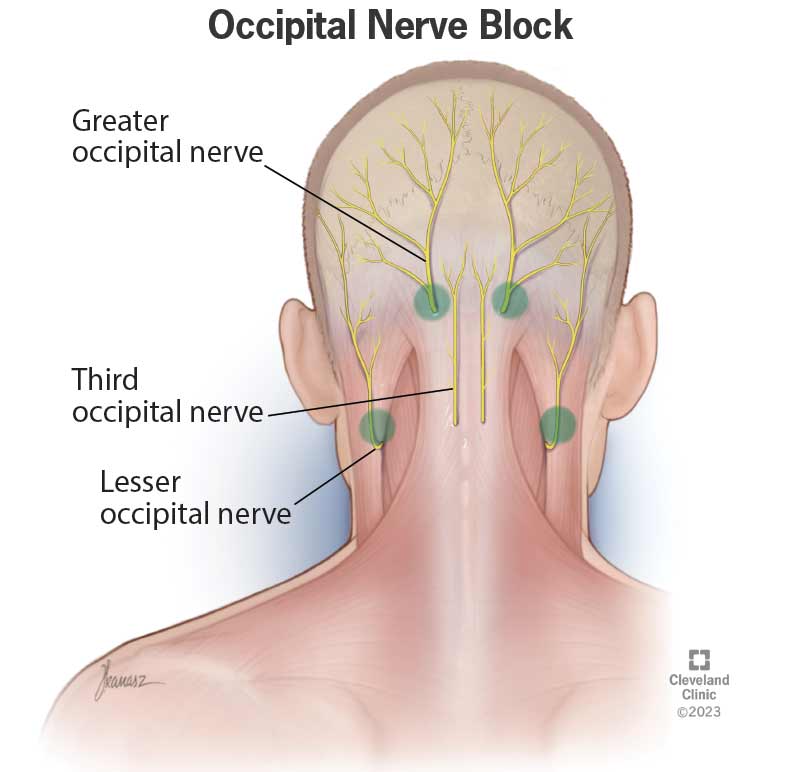An occipital nerve block may provide temporary pain relief for certain headache disorders, like occipital neuralgia and cluster headaches. It can also help with neck and head pain related to injuries, such as whiplash. The results can vary from person to person. Some people experience pain relief, while others don’t.
Advertisement
Cleveland Clinic is a non-profit academic medical center. Advertising on our site helps support our mission. We do not endorse non-Cleveland Clinic products or services. Policy

An occipital nerve block is an injection of anesthetic medication near an occipital nerve to provide temporary pain relief and help inflammation from headaches or other conditions. Sometimes, the injection may also include steroid medication.
Advertisement
Cleveland Clinic is a non-profit academic medical center. Advertising on our site helps support our mission. We do not endorse non-Cleveland Clinic products or services. Policy
Your occipital nerves are a group of nerves in the back of your head. They arise from the C2 and C3 spinal nerves (C is for “cervical” and refers to vertebrae in your neck). There are three types of occipital nerves, including:
Most people have two of each kind of occipital nerve — one for each side of their head.
Even though these nerves supply sensation to specific parts of your head, irritation of or damage to occipital nerves can sometimes make you feel pain elsewhere in or on your head, like near your eye. Healthcare providers call this referred pain.
Healthcare providers typically use occipital nerve blocks to help relieve pain from certain types of headaches when other treatment methods haven’t worked. An occipital nerve block can help treat several headache disorders, including:
Advertisement
It can also reduce associated symptoms resulting from nerve irritation, including tinnitus and ear pain (otalgia).
An occipital nerve block can also help treat:
Your healthcare provider may use an occipital nerve block for diagnostic purposes. It can help them determine if the head or neck pain you’re experiencing is coming from an occipital nerve or somewhere else. This can help them determine the best treatment plan.
You usually don’t have to do anything special to prepare for an occipital nerve block.
In some cases, your healthcare provider may recommend sedation for the procedure. If you’re receiving sedation, you’ll need to fast for six to eight hours before it. You’ll also need someone else to drive you home after the procedure if you received sedation.
Your provider will let you know what to do. Be sure to follow their instructions. Don’t hesitate to ask questions.
Healthcare providers typically perform occipital nerve blocks for pain management in an outpatient setting. This means you’re not admitted to a hospital for the procedure and can go home shortly after it.
In general, you can expect the following when you receive an occipital nerve block:
The procedure shouldn’t take more than five minutes.
If you had sedation for the procedure, you’ll rest for 15 to 30 minutes after the injection. A nurse will also observe you during this time to make sure you don’t have any unexpected side effects. You’ll then be able to go home.
If you didn’t have sedation, you’ll rest for about 10 minutes and then you can leave.
Potential benefits of an occipital nerve block include:
Advertisement
It’s important to note that not everyone experiences pain relief from nerve blocks. You may need to try other treatment options if this is the case.
Common side effects of an occipital nerve block include pain, redness and swelling at the injection site. These are usually mild and go away within a couple of days.
Other side effects may include:
If your injection contains steroid medication, you may experience temporary hair loss (alopecia) and skin thinning (atrophy) around the site of the injection.
Occipital nerve blocks are generally safe, and complications are rare. But possible risks or complications include:
Pain relief from an occipital nerve block varies considerably from person to person. The outcome can be difficult to predict. Successful occipital nerve blocks typically improve pain 20 to 30 minutes after the injection and can last for several hours to several months.
Lasting pain relief for occipital neuralgia and cervicogenic headache can require a series of several injections.
Advertisement
Contact your healthcare provider immediately if you experience any new symptoms or complications from the occipital nerve block, such as an infection or nerve issues like burning pain, weakness or tingling.
Occipital nerve blocks can help treat head and neck pain related to headache disorders or injuries. But the results can vary considerably from person to person. If you’re feeling anxious about receiving an occipital nerve block injection, don’t hesitate to ask your healthcare provider about it and the procedure. They can answer any questions you may have.
Advertisement
Last reviewed on 05/01/2023.
Learn more about the Health Library and our editorial process.